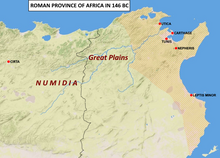Africa (Roman province)
Rome's first province in northern Africa was established by the Roman Republic in 146 BC, following its conquest of Carthage by Scipio Aemilianus[4] in the Third Punic War.However, upon his death, much of Jugurtha's territory was placed in the control of the Berber Mauritanian king Bocchus; and, by that time, the romanisation of Africa was firmly rooted.The Vandals crossed into Northwest Africa from Spain in 429 and overran the area by 439 and founded their own kingdom, including Sicily, Corsica, Sardinia and the Balearics.The restored Roman administration was successful in fending off the attacks of the Amazigh desert tribes, and by means of an extensive fortification network managed to extend its rule once again to the interior.Pockets of non-Romanized Berbers continued to exist throughout the Roman period, even such as in the rural areas of the deeply romanised regions of Tunisia and Numidia."The willing acceptance of Roman citizenship by members of the ruling class in African cities produced such Roman Africans as the comic poet Terence, the rhetorician Fronto of Cirta, the jurist Salvius Julianus of Hadrumetum, the novelist Apuleius of Madauros, the emperor Septimius Severus of Leptis Magna, the Christians Tertullian and Cyprian of Carthage, and Arnobius of Sicca and his pupil Lactantius; the angelic doctor Augustine of Thagaste, the epigrammatist Luxorius of Vandal Carthage, and perhaps the biographer Suetonius, and the poet Dracontius.The prosperity of most towns depended on agriculture.In addition to the cultivation of slaves, and the capture and transporting of exotic wild animals, the principal production and exports included the textiles, marble, wine, timber, livestock, pottery such as African Red Slip, and wool.The incorporation of colonial cities into the Roman Empire brought an unparalleled degree of urbanization to vast areas of territory, particularly in Northwest Africa.This flourishing trade allowed the Northwest African provinces to increase artisan production in rapidly developing cities, making them highly organized urban centers.[15] The urban population became increasingly engaged in the craft and service sectors and less in agrarian employment, until a significant portion of the town's vitality came from the sale or trade of products through middlemen to markets in areas both rural and abroad.As the craft developed and increased in quality and craftsmanship, the Northwest African creations began to rival their Italian and Grecian models and eventually surpassed them in merit and in demand.They can be attributed to specific pottery-making centers in northern and central Tunisia by way of chemical analysis, allowing archeologists to trace distribution patterns from their source through the regions and across the Mediterranean.If neither form nor decoration of the material is identifiable, it is possible to trace an item using chemical analysis, not just to a certain region but even to its place of production by comparing its makeup to a matrix of important northeastern and central Tunisian potteries.Pine forests, with a herb layer of grasses, were widespread and economically significant, especially in the humid zone, the northeast of modern Tunisia (the areas known as the Tell and parts of the Dorsal mountains).







ProvinceRoman RepublicRoman EmpireZama RegiaCarthagoClassical antiquityLate antiquityEarly Middle AgesThird Punic WarVandal Conquest of CarthageVandalic WarExarchateFall of CarthageAncient CarthageNumidiaVandal KingdomIfriqiyaTunisiaAlgeriaRoman provinceAfricaCarthageGulf of SidraBerbers9th century BCPhoeniciansWest AsiaMediterranean SeaRoman populaceHadrumetumSousseByzacenaHippo RegiusAnnabaHadriansenatorial provincelegionHistory of Roman-era TunisiaScipio AemilianusNumidianMassinissaNorthwest AfricaJugurthaBocchusCaesar's civil warSecond TriumvirateAugustan settlementsproconsulDiocletianAfrica ByzacenaDioecesis AfricaeVandalsand overran the area by 439SicilyCorsicaSardiniaBalearicsChalcedonianRoman AfricansArianismJustinianBelisariusshort campaignAmazighnorthwest Africanthe Roman possessions in SpainPraetorian prefecture of AfricaPraetorian prefecture of ItalyExarchate of AfricaMauricePhocasHeracliusConstantinoplesacked Carthageconquered the ExarchateMassyliiMasaesyliMauretaniaAfrica NovaMauretania CaesariensisMauretania TingitanaTripolitaniaMauretania SitifensisDiocese of SpainPraetorian prefecture of GaulDiocese of AfricaWestern Roman EmpireEl DjemBerber languagesromanisedRoman limesGaramantesGetuliRoman expeditions to Sub-Saharan AfricaPaul MacKendrickJuba IImosaicLouvreBerberAfrican Red SlipAncient Roman potteryterra sigillataoil lampareas known as the Tell and parts of the Dorsal mountainsamphoraepine nutsGrazingpomaceMercurySilviusDouggaEarly African ChurchChurch of CarthageArchdiocese of CarthageList of Roman governors of AfricaAfrican RomanceLex MancianaFossatum AfricaeRoman roads in AfricaKingdom of AfricaByzantine North AfricaChisholm, HughEncyclopædia BritannicaHarris, William V.F. W. WalbankR. M. Ogilvie